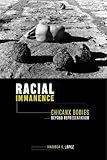Racial Immanence : Chicanx Bodies beyond Representation / Marissa K. López.
Material type: Computer filePublisher: New York, NY : New York University Press, [2019]Copyright date: ©2019Description: 1 online resource : 19 black and white illustrationsContent type:
Computer filePublisher: New York, NY : New York University Press, [2019]Copyright date: ©2019Description: 1 online resource : 19 black and white illustrationsContent type: - 9781479877676
- American literature -- Mexican American authors -- History and criticism
- Ethnicity in literature
- Mexican Americans in literature
- Race in literature
- LITERARY CRITICISM / Caribbean & Latin American
- AIDS
- Alejandro Morales
- Aztec
- Beatrice Pita
- Brazil
- Cecile Pineda
- Chicano
- Chicanx art
- Chicanx literature
- Chicanx performance
- Chicanx punk
- Dagoberto Gilb
- Gil Cuadros
- Ken Gonzales-Day
- Mexican American
- Rafael Lozano-Hemmer
- Rosaura Sánchez
- Sheila Ortiz Taylor
- Stefan Ruiz
- Texas
- accordion
- affect
- barbasco
- biometrics
- digital installation art
- hormones
- immanence
- indigeneity
- mass graves
- materiality
- narrative
- photography
- posthumanism
- punk
- queer
- race
- representation
- science fiction
- soldiers
- theater
- theory
- visuality
- 810.986872073 23
- PS153.M4 L665 2020
- online - DeGruyter
| Item type | Current library | Call number | URL | Status | Notes | Barcode | |
|---|---|---|---|---|---|---|---|
 eBook
eBook
|
Biblioteca "Angelicum" Pont. Univ. S.Tommaso d'Aquino Nuvola online | online - DeGruyter (Browse shelf(Opens below)) | Online access | Not for loan (Accesso limitato) | Accesso per gli utenti autorizzati / Access for authorized users | (dgr)9781479877676 |
Browsing Biblioteca "Angelicum" Pont. Univ. S.Tommaso d'Aquino shelves, Shelving location: Nuvola online Close shelf browser (Hides shelf browser)

|

|

|

|

|

|

|
||
| online - DeGruyter Muslim American City : Gender and Religion in Metro Detroit / | online - DeGruyter Educated for Freedom : The Incredible Story of Two Fugitive Schoolboys Who Grew Up to Change a Nation / | online - DeGruyter Gilded Suffragists : The New York Socialites who Fought for Women's Right to Vote / | online - DeGruyter Racial Immanence : Chicanx Bodies beyond Representation / | online - DeGruyter Beyond Recidivism : New Approaches to Research on Prisoner Reentry and Reintegration / | online - DeGruyter Organizing While Undocumented : Immigrant Youth's Political Activism under the Law / | online - DeGruyter Coming Out of Communism : The Emergence of LGBT Activism in Eastern Europe / |
restricted access online access with authorization star
http://purl.org/coar/access_right/c_16ec
Winner, 2021 NACCS Book Award, given by the National Association for Chicano and Chicana StudiesExplores the how, why, and what of contemporary Chicanx culture, including punk rock, literary fiction, photography, mass graves, and digital and experimental installation artRacial Immanence attempts to unravel a Gordian knot at the center of the study of race and discourse: it seeks to loosen the constraints that the politics of racial representation put on interpretive methods and on our understanding of race itself. Marissa K. López argues that reading Chicanx literary and cultural texts primarily for the ways they represent Chicanxness only reinscribes the very racial logic that such texts ostensibly set out to undo.Racial Immanence proposes to read differently; instead of focusing on representation, it asks what Chicanx texts do, what they produce in the world, and specifically how they produce access to the ineffable but material experience of race. Intrigued by the attention to disease, disability, abjection, and sense experience that she sees increasing in Chicanx visual, literary, and performing arts in the late-twentieth century, López explores how and why artists use the body in contemporary Chicanx cultural production. Racial Immanence takes up works by writers like Dagoberto Gilb, Cecile Pineda, and Gil Cuadros, the photographers Ken Gonzales Day and Stefan Ruiz, and the band Piñata Protest to argue that the body offers a unique site for pushing back against identity politics. In so doing, the book challenges theoretical conversations around affect and the post-human and asks what it means to truly consider people of color as writersand artists. Moving beyond abjection, López models Chicanx cultural production as a way of fostering networks of connection that deepen our attachments to the material world.
Mode of access: Internet via World Wide Web.
In English.
Description based on online resource; title from PDF title page (publisher's Web site, viewed 26. Mrz 2024)


